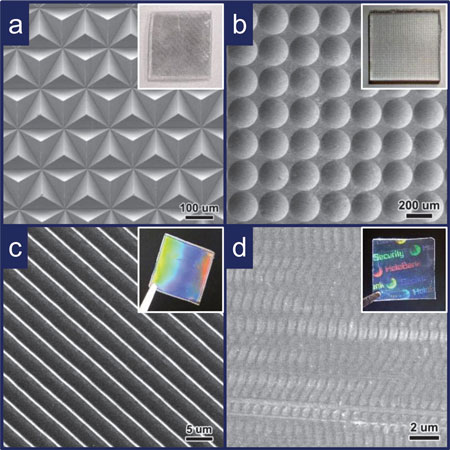| Posted: Mar 04, 2013 | |
A new generation of programmable shape-memory micro-optics |
|
| (Nanowerk Spotlight) So-called shape memory polymers have the ability to reassume their original shape following temporary deformation. This function can be activated by means of external stimuli such as temperature change, light, or magnetic fields. Researchers have now shown that they can mold shape memory polymers into shapes relevant for micro-optics, and that they can exploit shape memory effects in this context to develop new kinds of programmable optical components. | |
| "Micro-optics based on surface relief structures have emerged as an exciting research area in the past decades and many commercial products are presently available," John A. Rogers, Professor of Materials Science and Engineering at the University of Illinois at Urbana-Champaign, tells Nanowerk. "Glass, fused silica, quartz, and acrylates are the most common materials used for these technologies. As a result, micro-optical components are generally structurally rigid and not deformable." | |
| In their new work, reported in a recent online edition of Advanced Functional Materials ("Deformable, Programmable, and Shape-Memorizing Micro-Optics"), Rogers' research group demonstrates a series of deformable, shape-memorizing micro-optics using a shape memory elastomer. | |
| "We demonstrated two new things" explains Rogers. "Firstly, it is possible to mold, with nanoscale accuracy, fine feature of relief into the surfaces of classes of polymers that exhibit shape memory effects, and secondly, such capabilities can be used to enable a variety of micro-optical elements – microlenses, retroreflective surfaces, diffraction gratings and surface holograms – that offer the ability to program, in a spatially addressable way, their properties." | |
| In their work, the researchers showed that, through shape memory programming, the microstructures of the micro-optics can be altered at both the global and local levels, in a spatially controlled manner. Heating the material reverses the shape changes and restores the original optical function. | |
| "More importantly" Rogers points out, "these micro-structure changes translate directly into changes in various optical properties, leading to a new generation of programmable micro-optics." | |
| The shape memory polymer used by Rogers' team is is obtained by crosslinking semi-crystalline poly(ethylene-co-vinyl acetate) (EVA) which is a low cost commodity polymer widely used in industry. After radical initiated thermal crosslinking, however, EVA is highly transparent, due to the low crystallinity and the fact that the crosslinking prohibits the formation of relatively large crystals that interfere with visible light transmission. | |
 |
|
| SEM images of surface relief microstructures on several replica molded micro-optics: a) a microprism array, b) a microlens array, c) a transmission grating, and d) a white-light hologram. (Insets show macroscopic optical images of the corresponding micro-optical devices, collected under ambient lighting.) (Reprinted with permission from Wiley-VCH Verlag) | |
| The researchers fabricated their micro-optic devices by imprinting microstructures on heated crosslinked EVA. When cooled, they the can be peeled away from the mold. | |
| Rogers notes that the programmable nature of the micro-optics can be further manipulated via the additional integration of transparent indium tin oxide (ITO) micro-heater arrays onto the back surface of the micro-optics device. | |
| "The micro-heaters can be individually activated – without affecting neighboring areas – to trigger shape recovery and a corresponding change in optical property at the location of the heating," he explains. " One can envision programming them in a way that allows overall system performance to be optimized, for various application specific contexts." | |
| For example, one might envision programmable security holograms, or holographic storage components that can be 'erased' to eliminate sensitive data. More generally, Rogers likes the idea of these systems as collection, focusing and wavelength splitting components for classes of optical devices that implant in the body for characterizing properties of tissue, or for controlling behavioral responses (e.g. optogenetics). | |
| "In the future, we would also like to develop polymers that allow reversible, two-way programmability," he says. | |
 By
Michael
Berger
– Michael is author of three books by the Royal Society of Chemistry:
Nano-Society: Pushing the Boundaries of Technology,
Nanotechnology: The Future is Tiny, and
Nanoengineering: The Skills and Tools Making Technology Invisible
Copyright ©
Nanowerk LLC
By
Michael
Berger
– Michael is author of three books by the Royal Society of Chemistry:
Nano-Society: Pushing the Boundaries of Technology,
Nanotechnology: The Future is Tiny, and
Nanoengineering: The Skills and Tools Making Technology Invisible
Copyright ©
Nanowerk LLC
|
|
|
Become a Spotlight guest author! Join our large and growing group of guest contributors. Have you just published a scientific paper or have other exciting developments to share with the nanotechnology community? Here is how to publish on nanowerk.com. |
|
